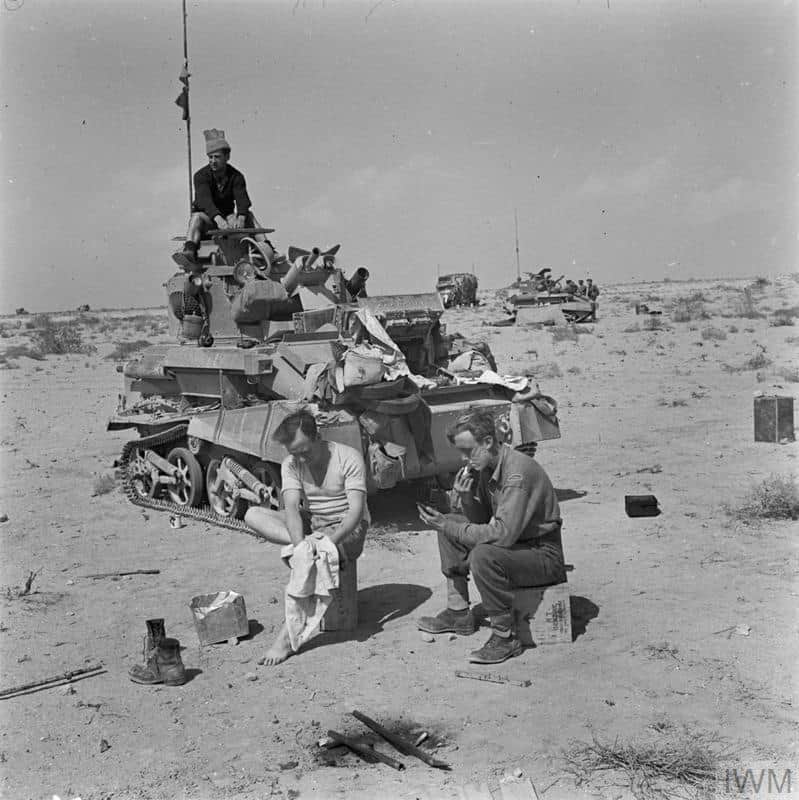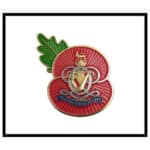Beda Fomm
In this Battle, the 7th Armoured Division, after a brilliant desert march to outflank the enemy, annihilated the remnants of the Italian Tenth Army.
The Honour is borne on the Guidon of the 7th Hussars.
Detail
The advance began on 5th February and reached Msus, northeast of Beda Fomm later that morning, hitting the coast road near Sidi Saleh about noon, 10 miles south of Beda Fomm.
Within 2 hours a company of 2nd Rifle Brigade were in position across the road with two more companies screening the positions occupied by 4 RHA. With rifle and machine gun ‘A’ Company, the Rifle Brigade soon brought the Italian column to halt, ably supported by ‘C’ Battery, 4 RHA and ‘C’ Squadron, 11th Hussars.
The positions of 2 Rifle Brigade were such that ‘A’ and ‘B’ Companies of the Rifle Brigade were astride the road, with ‘S’ Company stretched from the road to the sea and ‘C’ Company in reserve about 500 yards behind. It was now that 7th Hussars, supported by ‘A’ Squadron, 2 RTR, which had 6 of the faster A13 tanks were ordered by Brigade Caunter to attack the Italians on the road nearer to Beda Fomm.
The 7th Hussars destroyed a transport column and ‘A’ Squadron, 2 RTR joined the action just before 1800hrs when they attacked an Italian infantry column.
The fighting continued all day on either side of the road, but despite increasing pressure and a growing shortage of ammunition, the Rifle Brigade and 11th Hussars held out and continued to block the road, with sporadic fighting throughout the night of 5th/6th February. At about 10:45, in heavy rain, on the 6th some Bersaglieri units supported by a few L-3 Light Tanks attacked the roadblock defended by 11th Hussars and 2 Rifle Brigade.
The attack consisted of three columns, each with 300 vehicles. Two half-hearted attacks were beaten off and Italians started to surrender after being engaged by anti-tank guns, but it took another hour to beat off the third more determined attack, which was supported by guns and tanks. The toll of prisoners was increasing into the thousands and to the south, the KDG squadron was also becoming embarrassed by the number of prisoners they took, too.
During the battle, a continual stream of prisoners came in, and all had to be hastily disarmed and sent off in the direction of the improvised “cage” guarded by a platoon of ‘C’ Company, 2 Rifle Brigade. On 6th February the rest of the 4th Armoured Brigade arrived and struck the Italians in their left flank at Beda Fomm further north. With this the Italian rout was complete.
However, there was no quick collapse and the Italians continued to press home their attacks, with tenacity and increasing desperation, especially as they had the advantage of numbers and a large supply of ammunition. Seven miles north of the roadblock were the only landmarks in the area, which were a white Mosque and two windmills, on a low ridge known as the Pimple.
It was north of here that the light tanks from 3rd and 7th Hussars were harassing the extended flanks of the Italian column and engaged much of the Italian artillery. It was 2 RTR with its 19 Cruisers that did the most damage. The 3rd Hussars put 8 light tanks around the Pimple and broke up wave after wave of Italian tanks, which were coming down the road in batches of thirty, only to encounter cruisers tanks of 2 RTR which were in hull-down positions. 2 RTR probably accounted for 100 tanks in total in the three-day battle, but the Italian artillery managed to knock out four of its tanks. One of its tanks fired 112 rounds of 2-pdr ammunition and knocked out at least 10 M-13’s in the process. At one time the ammunition actually run out, but the supply lorries arrived at 1300 hrs, by when 7th Hussars and 2 RTR were down to ten operational cruisers.
During the fighting, the Pimple changed hands many times and at the roadblock, the 2nd Rifle Brigade had to stop infiltration by the Italians through the sand dunes by the sea, but the support from the guns of 4 RHA was magnificent, with them knocking out about six Italian tanks. However, but the middle of the afternoon the key point in the battle was reached.
Although the light tanks of 3rd and 7th Hussars were very effective in breaking up the columns of advancing Italian Infantry, they were vulnerable to the fire from the Italian M-13 tanks. The ammunition for the tanks and the 25-pdrs was in short supply and the forward observation post for the artillery had been knocked out. It was now that after many requests for 1 RTR to be released from the Divisional reserves, it finally was.
1 RTR arrived by one of the windmills on the Pimple as 7th Hussars and 2 RTR were refuelling and re-arming. The commander of Cruiser tanks from 1 RTR, surveyed the scene and saw for miles in each direction that the road was packed full of lorries, guns, cars, buses and tanks. 1 RTR fired everything they had and the column dispersed in every direction, thought some of the Italian guns were brought into action and did score hits on the tanks, inflicting no damage.
The arrival of 1 RTR had averted the crisis for 4 Armoured Brigade, as at midday only six tanks had been in action at ‘The Pimple’ as others had been knocked out, broken down or were replenishing. Elsewhere a Battery Commander (Major Burton) from 106th RHA having seen his last gun crew wiped out by Italian machine gun fire, drove the portee away to check the gun was still serviceable, which it was. Then he and his batman proceeded to destroy five M-13 tanks in return.
At 14:20 the British attacked an Italian column and about an hour later it was reported that Italian tanks were trying to escape to the Northeast. During the afternoon the battle remained evenly balanced as the British had no more tanks reserves and were greatly outnumbered by the Italians.
The 7th Hussars had found the rear of the Italian column and were working their way down it with no one behind them, while at the other end 2 RTR, who now had just seven Cruisers left (including two from RHQ), were facing a force of over twenty tanks with another thirty further back, supported by artillery. In the middle 1 RTR were pursuing about 20 Italian tanks to the Northwest and the three remaining tanks for 3rd Hussars were moving the contact the enemy retreating northwestwards, too.
As night fell 4th Armoured Brigade withdrew to leaguer, accompanied by 1 RTR, just north and south of Beda Fomm. Including the tanks from 1 RTR, the Brigade now had 39 undamaged tanks, 48 hit by gunfire, with 8 knocked out, one burn out and another 8 out of action for unknown reasons. This was a total of 101 tanks. To the north Support Group was pushing towards Ghemines to attack the Italians in the flank and the rear.
At about 21:00 the Italians attacked the Riflemen with three columns supported by tanks. After avoiding a small minefield they broke into the Rifle Brigades lines, mainly due to the losses in the anti-tank gun crews which limited the support they could provide.
The line did hold and 500 prisoners were rounded up, and at about 22:00 two more guns from 106 RHA arrived to bolster the defences. More mines were laid and when the next attack started the lead vehicle was blown up and another 150 prisoners taken. At midnight a column moving across the front of the roadblock was broken up and at 04:00 on the 7th two M-13 tanks were captured by just two men from the Rifle Brigade.
All over the battlefield there were knocked-out, ditched and abandoned tanks, burnt-out vehicles and many Italians roving about trying to surrender.
During the night of 6th/7th December it was quiet in the Beda Fomm area and at dawn 7th Hussars sent patrols out to the north and northwest, while 2 RTR was ordered to move south to assist at the roadblock at Sidi Saleh, but arrived too late to take part in the final stages of the battle.
The Support Group soon made contact with 7th Hussars. At 11:00 General Virginio, Chief of Staff on 10th Italian Army arrived at the Headquarters of 4 Armoured Brigade with the Army Staff.
Earlier to the south at the roadblock near Sidi Saleh, the Battalion HQ of 2 Rifle Brigade had been heavily shelled at 06:30 and shortly afterwards two large columns with tank and artillery support attacked. The column on the road managed to penetrate into the reserve company area before it was stopped by accurate artillery fire and one tank even reached the Battalion HQ before it was knocked out. The lorries carrying the infantry were soon halted by the heavy small arms fire and the occupants started to surrender.
With the attack halted white flags began to appear all along the Italian column. Italian General Tellera had been wounded and later died and Generals Bignani, Negroni, Bardini and Giuliano, along with dozens and dozens of Brigadiers and Colonels had all been captured, along General Bergonzoli, who had so long evaded the British.
With General Bergonzoli’s capture, the battle was over and the 10th Italian Army ceased to exist. In total, over 25,000 prisoners, 100 tanks, 216 guns, and 1,500 other vehicles were captured.



